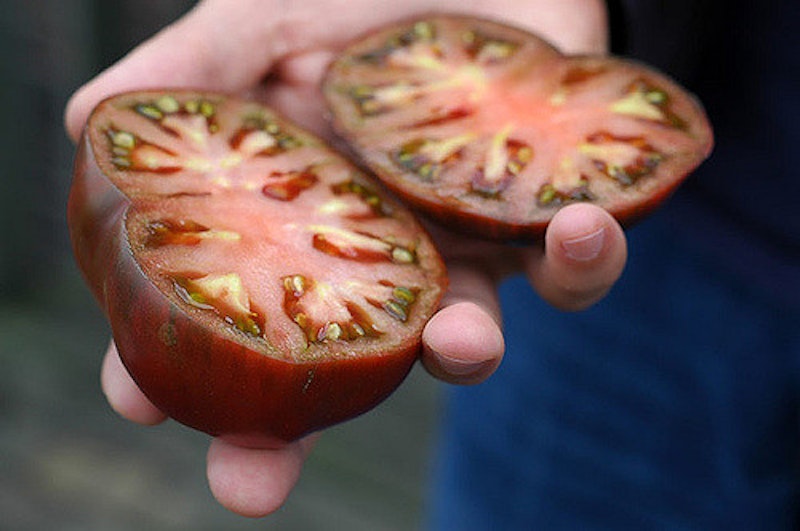At home on the last day of August, finishing a lunch of pesto on pumpernickel, I needed another tomato. Glancing into the cage outside the dining room window, I could see that a couple of Black Krims, my favorite of the heirlooms, looked ripe enough. I went out the back door into the sunshine, squatted in front of the cage’s tent-flap opening, and moved the handful of bricks that held the netting firm against the ground. I tugged the netting aside and stooped to enter.
The Black Krims I had my eye on were still deep green up near their stems, shading to gazpacho-pink bottoms. They hadn’t yet achieved the bruise-purple hue that signifies perfection. I reached for them anyway. Warm to the touch, they each released from the withering vine with a light half-twist. Sliced and topping the pesto, their flavors were rich and subtle. But not transporting.
There was no denying it. Peak Tomato had ended.
It felt like only last weekend when the season began. My brother John and I drove up to Gaithersburg to the hardware store that carried the right diameters of PVC piping. John, the pathfinder, the one who cultivates tomatoes from seed under grow lamps in his study, is my gardening spirit guide. But it was my idea to use PVC pipes to build a tomato cage. My innovation was to bury an 18-inch piece of pipe at each corner of the enclosure to support tall corner posts of narrower gauge. The corner posts hold up a rectangle of PVC pipe to create a simple frame. It becomes a cage when you cover the top and sides with netting, taking care to bury the bottom edges and seal all seams with wire twists.
Why all these construction efforts? Another symptom of a security culture run amok? Sadly—or happily—not. The Maryland suburbs teem with game. The deer are the first, and arguably the greatest, menace. They’ll chomp the whole tomato plant long before the first blossoms appear. The birds and chipmunks have more refined tastes, waiting for the fruit to ripen before they begin sampling. The tomato grower faces threats from all sides. When I posted a photo of my completed tomato cage on Twitter, someone tweeted back: “Two tomatoes enter, one tomato leaves.” The reality is that, without the cage, no tomato would survive.
But survive and thrive they did. My garden reached Peak Tomato during the middle weeks of August. Those were days of bounty and munificence. Every evening I luxuriated in the incomparable flavors of tomatoes fresh off the vine, boosted with a dash of sea salt. I gave prime specimens to friends and neighbors. I committed the atrocity of boiling down a dozen or more tomatoes to make a simple spaghetti sauce. It was like using the finest cashmere to make a shopping bag. During that period of abundance I even adopted my sister Cecilia’s controversial pizza practice of replacing the sauce with slices of fresh tomato. Still, even with all of this, I couldn’t keep up with the supply.
But today the cage, once an almost impenetrable tangle of contending vines, has become emptier, more airy. Leaves are curling and whole sections of vine have shriveled and collapsed. Struggling to reach ripeness, perhaps a dozen green tomatoes still cling to twisted stalks. And slowly darkening in the back corner, the last two Black Krims.
And that’s it. I’m humbled. Reduced to subsistence level. So now, if I’m invited to dinner, I bring along a couple of cucumbers. Those vines are unstoppable.

